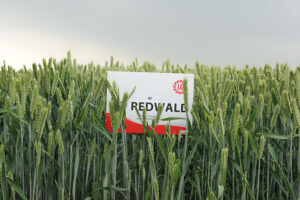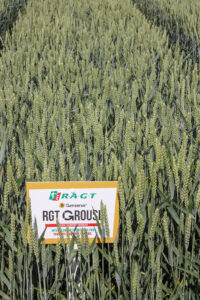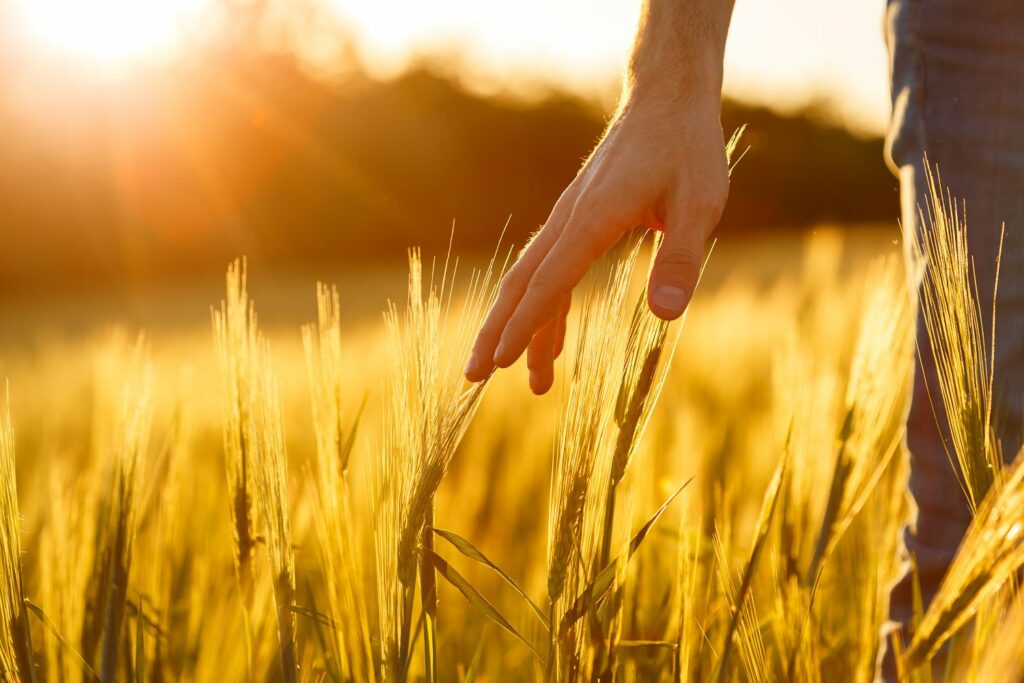Quality over quantity: Limited number of new arrivals bring big boost to the AHDB RL
26th December 2022
AHDB’s online edition of the Recommended Lists for cereals and oilseeds (RL) 2023/24 may feature fewer new varieties than previous Lists, but some of the newcomers deliver large yield increases, especially in barley and oilseed rape.
Launched on 28th November 2022, the latest RL sees the first new winter malting barley and winter oat varieties for several years.
The latest update was released alongside details of a major review of the RL, which aims to help the variety trialling project keep pace with the industry’s evolving requirements.
Paul Gosling (right), who manages the RL at AHDB, said: “We’ve seen relatively few new varieties on the lists this year. Several years of plant breeding advances mean the recommendation bar is set high. Relatively few candidate varieties performed better than the best listed varieties to secure a recommendation.”
New barley varieties
RL 2023/24 includes several new barley varieties that bring strength to yield and disease resistance.
The winter barley list includes the first malting variety to be added since 2018. Buccaneer, marketed by Elsoms Seeds and bred by Sejet Plant Breeding, offers a significant yield increase over the established two-row malting varieties, Craft and Electrum, alongside good disease resistance.
George Goodwin, technical manager for Elsoms Seeds, said: “With a treated yield of 99.7%, Buccaneer is almost 4% ahead of nearest competitor Electrum, and offers growers the benefits of both a high untreated and treated yield, due to its excellent disease resistance package.

Buccaneer barley variety from Elsoms Seeds.
“On brown rust it scored an impressive 8.1, with a 7.2 for control of rhynchosporium, and in all NL trials it has shown very low susceptibility to both net blotch and brackling.
“With a current amber listing from the Malting Barley Committee, it has performed consistently well in malting trials showing good hot water extract, WORT viscosity and Beta-glucan levels. Based on the current malting test results we are very confident that Buccaneer will achieve full malting approval status by December 2023. Seed will be available for autumn 2023,” he concluded.
Two new two-row and one new six-row hybrid varieties add strength to winter barley feed yields (compared with current favourites). The two rows are Bolivia, from Agrii (bred by Nordic Seed), and LG Caravelle, from Limagrain. The latter offers a particularly high yield in the East region of 2% above hybrids, and an exceptionally high specific weight for a winter barley, of 71.8kg/hl. It is an early maturing variety with stiff straw; both important characteristics for a winter barley.
The new six-row hybrid SY Nephin, from Syngenta, is notable for its disease resistance rating of 8 for rhynchosporium.
There are six new spring barley varieties under evaluation by the Malting Barley Committee (MBC): three for brewing, two for brewing and malt distilling, and one for malt distilling. These offer improvements in yield and/or disease resistance (compared with the current market leaders, RGT Planet and Laureate).
The spring barley list sees feed variety Hurler added. Bred by Secobra and available through Agrii, high yield is its standout feature.
Mr Gosling commented: “RL 2023/24 delivers exciting potential for brewing and distilling. However, it is a tough market to break into, with varietal success determined by end users. As varieties can fail to make the grade, farmers should talk to merchants before growing them.”
Ongoing commitment
KWS’ ongoing commitment to breeding spring barleys that deliver in the malthouse and the field has been underlined by the addition of KWS Curtis to the 2023/24 AHDB Recommended List, says the company’s cereals product manager, Dr Kirsty Richards.
“The first of a pipeline of similar high performers now entering RL candidate trials, KWS Curtis is a strong all-round variety bred specifically to be easy to grow and manage whilst meeting the demands of the supply chain in an increasingly carbon footprint focused future.
“It’s a high yielding 2-row variety that outperforms the best in class for quality whilst delivering the highest spirit yields/ha of crop combined with reduced levels of carbon emissions throughout the production cycle.”
According to KWS UK spring barley breeder Dr Henry Barber, KWS Curtis’ resilience and performance has been tested in a variety of growing conditions across Europe with the variety having an agronomic profile perfectly suited to the UK.
“It’s a variety that performs well across the country with treated yields of 105% of controls in the East and 103% in the North and West regions with an average yield of 104% for the UK as a whole.
“These yields have been remarkably consistent over the last three years of trials despite very different spring seasons. Untreated yield is very high at 93%, too, giving growers a range of production options.” KWS Premis and KWS Nelis follow in the path of KWS Curtis, being high performance spring barleys with significant production and environmental potential, he reckons.
“Both varieties are currently progressing through the MBC testing system with KWS Premis being evaluated for brewing only and KWS Nelis as a dual-purpose variety.
“Both have very similar yields, quality potential and agronomic properties to KWS Curtis alongside its proven consistency across different growing seasons and regions of the UK.
“KWS Premis and KWS Nelis are now entering AHDB candidate trials for harvest 2023 and we have high hopes for them, too.”
Winter OSR
The winter oilseed rape list features three new UK-recommended hybrid varieties: Vegas and Turing, from LS Plant Breeding (LSPB), and Attica, from Limagrain. Turing and Attica have especially high yields in the North region.
Recommended for the East/West region, Murray, from LSPB, has a high yield and a resistance rating of 8 for stem canker. Recommended for the North region, LG Wagner, from Limagrain, achieved the highest yield in this region and is a shorter hybrid with stiff stems, combined with good light leaf spot resistance and good stem health.
A new conventional variety for the UK, Tom, from CBI, offers a small yield increase but adds options for this important seed-market component. The list also includes Beatrix from DSV – a new Clearfield variety for the North region.
Long-awaited winter oat
RL 2023/24 features the first newly added winter oat variety since RL 2018/19. Cromwell, from Senova, offers good yield and grain quality. New spring oat variety RGT Vaughan also features good grain quality.
RGT Vaughan is the first spring oat from RAGT to appear on the AHDB Recommended List after achieving full approval this autumn.
“This new variety features a powerful combination of high grain quality and good disease resistance,” said RAGT technical sales manager, Dr Cathy Hooper.
“Its specific weight is one of the best on the 2023/24 list at 52.3kg/hl, which is the second highest on the AHDB’s five-year report.
“RGT Vaughan also features consistently low screenings, at 2.3% over a 2mm sieve, and a decent kernel content of 72.9%. weight.”
The variety also stands well, thanks to its good straw strength that delivers an untreated lodging score of 7, and it is early ripening, providing extra insurance at harvest.
“RGT Vaughan features the best combination of untreated yield, at 93%, and disease resistance among its comparators, including an 8 for mildew and 4.4 for crown rust,” continued Dr Hooper. “Along with its good agronomic characteristics and yield, this suggests a spring oat with a very bright future,” says Cathy.

Redwald winter wheat variety from Limagrain.
Winter and spring wheat
For winter wheat, the latest RL includes one new UKFM Group 2 bread-making variety, KWS Ultimatum, and one new UKFM Group 3 biscuit-wheat variety, RGT Wilkinson. The list also adds two new feed varieties for the East/West region: hard-textured Oxford, from DSV, and soft-textured LG Redwald. The latter requires careful lodging management. There is also a new soft Group 4 for the North region, KWS Zealum, which is likely to be of interest to the distilling market.
Three new varieties have been added to the spring wheat list, offering good grain quality and yields: UKFM Group 1 KWS Harsum, which has particularly high yield, and UKFM Group 2 varieties KWS Alicium and KWS Lightum.
Strong breeder portfolio
“The total number of wheat varieties we have on the 2023/24 AHDB Recommended List stands at 13 and it is likely around 40% of the wheat harvested in 2023 will be a KWS variety of one type or another,” commented KWS UK country manager Will Compson.
“Our varieties span all four production groups, be it premium specification Group 1 milling wheats like KWS Zyatt, varieties with high untreated yields like Group 2 KWS Extase, Group 3 biscuit making options or outright barn fillers like Group 4 KWS Dawsum.”
KWS UK wheat breeder Mark Dodds said all five KWS RL wheat additions add something new to the current range of UK cropping options.
“Group 4 soft variety KWS Zealum, for example, is a great example of a resilient wheat that delivers strong field performance with excellent yield potential for growers.
“Recommended for the North of the country, KWS Zealum has an average yield of 102% in this region which rises to over 106% when it is drilled before 25th September.
“This is an important characteristic for Northern growers, most of whom would complete the vast majority of their wheat sowing before this date.
KWS Ultimatum brings the high untreated yield performance growers have come to expect from the KWS Group 2 stable along with excellent grain and field performance, Mr Dodds reckons.
“KWS Ultimatum achieves a commendable yield of 101% of controls for the whole of the UK, fractionally behind KWS Extase, but this rises to 103% for the North.
“It delivers great performance in the second wheat spot, where 60% of milling wheats and 40% of wheat overall is grown, achieving 102% of controls and it performs equally well on heavy and light soils.”
KWS Harsum is a Group 1 spring variety in the same mould as existing RL variety KWS Ladum, whilst KWS Alicium and KWS Lightum are exciting new Group 2 options, explained KWS spring wheat breeder Dr Reiner Bothe.
“KWS Harsum becomes the highest yielding spring-sown Group 1 variety on the RL at 102% of control just fractionally ahead of KWS Ladum and some 7% ahead of the next variety in the class.
“Harsum’s good protein content is complemented by a high HFN and the best specific weight in the Group 1 spring sector at 78.3kg/hl.
“With 7s for mildew, yellow rust and septoria plus OWBM resistance, the variety has one of the best agronomic packages in its class.
“Meanwhile, Group 2 KWS Alicium couples outstanding yields with fabulous grain quality, breadmaking performance and OWBM resistance and represents a new type of genetics for the spring wheat milling sector thanks to its German parentage.
“With a treated yield of 105% it’s a real high performer with grain quality to match. A 13.3% protein content, HFN of 346 and specific weight of 80.3kg/hl really do set a new benchmark for its class.
“Solid agronomic performance with an 8 for mildew resistance and a 7 for septoria rounds out the package making it one of the most complete added-value spring-sown options there is.”
KWS Lightum is another spring-sown Group 2 variety which offers growers high yields and excellent grain, featuring a protein content of 13.4%, HFN of 325 and specific weight of 78.4, he points out.
“Like its new KWS stablemates, Lightum also has OWBM resistance coupled with excellent disease resistance including an 8 for mildew resistance, 7 for brown rust and 6 for septoria contributing to a strong disease package.”
British-bred
DSV Oxford becomes the company’s latest British-bred hard Group 4 winter wheat to join the AHDB Recommended List with a performance very close to the highest yielder in the class DSV Champion, said DSV UK’s Sarah Hawthorne.
“DSV Oxford is another success of our Wardington-based breeding programme combining high treated and untreated yields with a robust disease package borne out of our breeding station’s relatively westerly location.
“Our focus in recent years has been on balancing high outright yield potential with consistency of production and robust agronomics focused on giving UK producers an added layer of security in an increasingly difficult production environment.
“Recommended for the East and West region, DSV Oxford follows DSV Theodore, still the cleanest wheat on the new 2023/24 AHDB RL, and the highest yielding hard Group 4 winter wheat DSV Champion sitting neatly between them in terms of performance and agronomics.”
New standards for yield
Despite requiring careful lodging management, LG Redwald sets a new standard for high yielding wheats, yielding 107% in the UK, 107% in the east and 109% in the west. As a soft wheat, the variety also offers potential for distilling.
The variety has an excellent disease resistance profile, with very good septoria resistance as well as orange wheat blossom midge (OWBM) resistance.
“It is an exciting variety that should deliver for growers in 2023/24, if supported with good agronomic practise to ensure it meets its full potential on farm, and comes at a time when growers are looking more than ever to maximise output in order to maintain profit in times of increasing costs,” said Ron Granger, Limagrain’s arable technical manager.

Grouse wheat variety from RAGT Seeds.
Next step in BYDV resistant wheat
The next generation of BYDV resistant wheats comes a step closer to market following the promotion of RGT Grouse to the AHDB Candidate List 2023.
RGT Grouse is a Group 4 hard variety on a Santiago genetic background, with good yield potential and disease resistance.
It is the latest in the pipeline of RAGT Seeds’ ground-breaking Genserus BYDV-resistant varieties and has the added benefit of resistance to orange wheat blossom midge.
“This is the first of several varieties coming through with this double resistance, enabling many growers to produce insecticide-free wheat, which has obvious attractions within all markets,” said RAGT’s cereal and OSR product manager, Tom Dummett.
“RGT Grouse is a slower developing type, so is highly suited to earlier sowings when the risk of BYDV is at its highest,” he adds.
“It is a good-looking wheat with a prostrate autumn and winter growth and high tillering capacity, as well as excellent tiller retention that lends itself to a denser canopy.
“Ear fertility is good, with an outstanding bright finish.”
Anticipating keen demand for the variety, RAGT has fast-tracked seed production, so significant quantities of commercial seed will be available for autumn 2023, when the variety will be up for full recommendation.
“RAGT is the first company to introduce the BYDV resistance trait into a commercial wheat line in Europe,” says Tom. “The resistance trait offers protection from the day the wheat is planted to the day it is harvested, for less than the cost of a single pyrethroid spray.
“It greatly simplifies crop management, removing the need to monitor and control aphid populations with foliar-applied insecticide sprays while benefiting the environment.”

